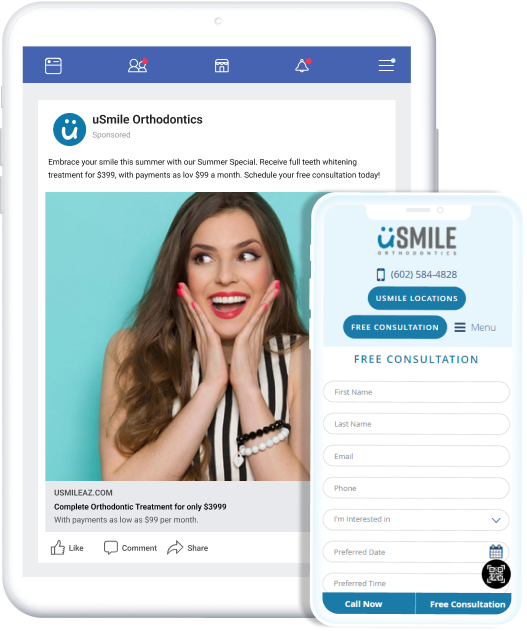Looking to boost your orthodontic brand and reach more potential patients? Facebook Ads could be the answer! With the ability to target a specific audience, Facebook Ads allow you to advertise your services directly to dentists and orthodontists who are in need of an SEO agency. And what’s even better? Ortho Advertising, located in Philadelphia, can help you navigate the world of Facebook Ads to ensure your brand gets the exposure it deserves. Say goodbye to generic marketing strategies and hello to targeted advertising that yields real results.
Benefits of Facebook Ads for Orthodontic Brands
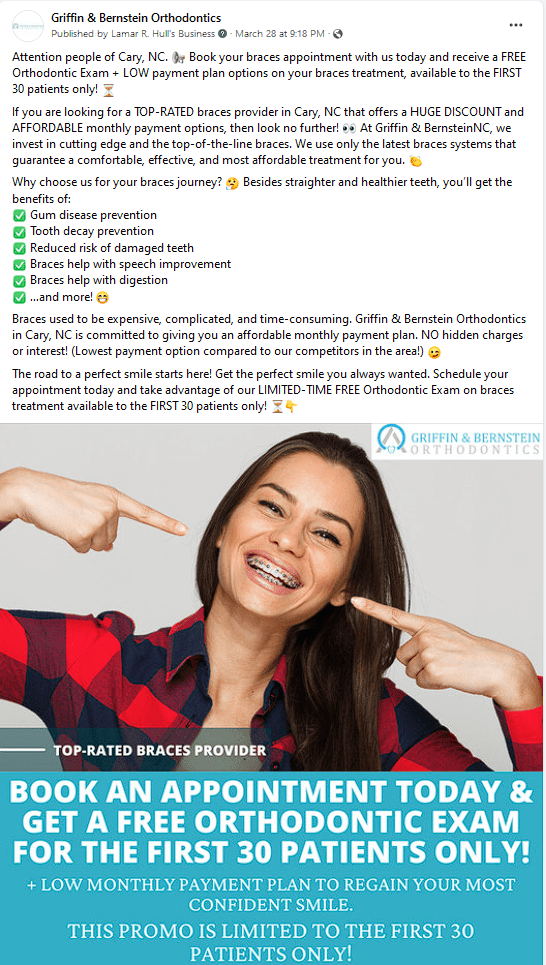
1. Increased Visibility and Reach
With over 2.8 billion monthly active users, Facebook provides an enormous platform for orthodontic brands to increase their visibility and reach a wide audience. By leveraging Facebook’s extensive user base, you can ensure that your brand message reaches potential patients who may be interested in orthodontic treatments. Whether they’re looking for braces, clear aligners, or other orthodontic services, Facebook ads can help you connect with individuals at various stages of their treatment journey.
2. Targeted Advertising
One of the key advantages of Facebook ads is the ability to target specific demographics and interests. By understanding your target audience, you can tailor your ads to reach the right people at the right time. With detailed targeting options such as age, gender, location, and interests, you can ensure that your ads are shown to the individuals who are most likely to be interested in your orthodontic services. This targeted approach not only maximizes the effectiveness of your campaigns but also minimizes wasted ad spend.
3. Cost-Effective Marketing
Orthodontic advertising can often be expensive, especially when using traditional channels such as print media or television. However, Facebook ads offer a cost-effective alternative for orthodontic brands looking to promote their services. With the ability to set a budget that suits your needs and the flexibility to adjust it as necessary, you have control over your marketing spend. Additionally, Facebook’s ad targeting capabilities help optimize your ad performance, ensuring that your budget is being allocated towards reaching the most relevant audience.
4. Direct Communication with Potential Patients
Facebook ads provide a unique opportunity for orthodontic brands to engage in direct communication with potential patients. Through the use of features such as Messenger ads or lead generation ads, interested individuals can easily reach out to your brand for more information or to schedule appointments. This direct line of communication not only enhances the user experience but also allows you to build a relationship with your audience, addressing their concerns and guiding them through their treatment journey.
Understanding Your Target Audience
1. Identifying the Ideal Patient Profile
To maximize the effectiveness of your Facebook ad campaigns, it’s crucial to identify your ideal patient profile. Consider the demographics, interests, and behaviors of your existing patients to create a detailed profile that represents your target audience. Understanding who your ideal patients are will help you tailor your ad content and targeting strategies to attract individuals who are most likely to be interested in your orthodontic services.
2. Analyzing Patient Demographics
Analyzing patient demographics can provide valuable insights into the characteristics of your target audience. Look at factors such as age, gender, location, and income level to gain a deeper understanding of who your potential patients are. By understanding the demographics of your target audience, you can create more targeted and relevant Facebook ad campaigns that resonate with the right individuals.
3. Exploring Patient Interests and Behaviors
In addition to demographics, exploring patient interests and behaviors can help you refine your Facebook ad targeting even further. Consider the hobbies, activities, and online behaviors of your target audience to uncover their preferences and habits. This information can be used to create compelling ad content that speaks directly to their interests, increasing the likelihood of engagement and conversion.
Establishing Clear Campaign Objectives
1. Increasing Brand Awareness
One of the primary objectives of orthodontic brands on Facebook is to increase brand awareness. By utilizing Facebook ads, you can expose your brand to a wide audience and ensure that potential patients are familiar with your services. Focus on creating visually appealing ads that showcase your brand identity and unique selling points to capture the attention of your target audience and leave a lasting impression.
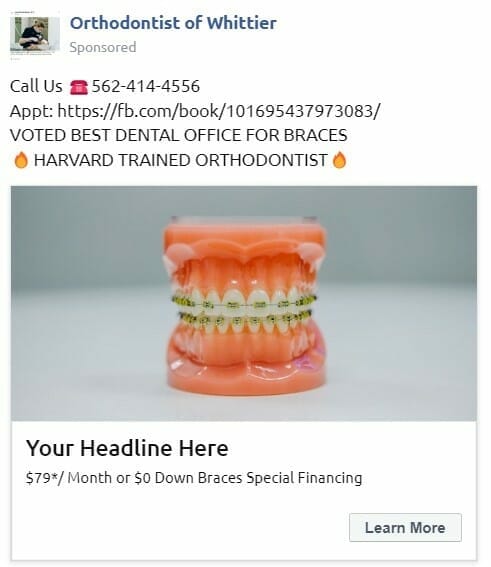
2. Generating Leads and Appointments
Another important objective for orthodontic brands is to generate leads and appointments. Use Facebook ads to drive individuals to your website or landing page, where they can find more information about your services and schedule appointments. Incorporate compelling call-to-actions in your ad copy to encourage interested users to take the next step and make contact.
3. Promoting Specific Services or Offers
If you’re looking to promote specific services or offers, Facebook ads can be highly effective. Highlight your unique treatment options, special promotions, or seasonal offers to attract the attention of individuals who are actively seeking orthodontic treatment. By emphasizing the value and benefits of your services, you can entice potential patients to choose your practice over competitors.
4. Driving Traffic to Your Website
Having a strong online presence is essential for any orthodontic brand. Facebook ads can help drive traffic to your website, where individuals can learn more about your brand, services, and team. Utilize compelling visuals and engaging ad copy to pique the interest of users and encourage them to visit your website for more information. Additionally, consider incorporating lead capture forms or live chat options on your website to further enhance the user experience and facilitate communication.
5. Enhancing Patient Engagement and Loyalty
Building a community of engaged patients is key to the success of any orthodontic brand. Facebook ads can be used to foster patient engagement and loyalty by promoting patient testimonials, sharing informative content, or initiating conversations through social media channels. By regularly engaging with your audience, you can foster a sense of trust and loyalty, ensuring that patients choose your brand for their orthodontic needs and recommend your services to others.
Crafting Compelling Ad Creative
1. Eye-Catching Visuals
When it comes to Facebook ads, visuals play a crucial role in grabbing the attention of users as they scroll through their news feeds. Use high-quality images or videos that showcase your orthodontic treatments, facilities, and satisfied patients. Consider using vibrant colors and compelling visuals that evoke positive emotions and curiosity. Remember, visually appealing ads are more likely to capture the attention of users and encourage them to engage with your brand.
2. Persuasive Ad Copy
While visuals are important, the accompanying ad copy also plays a vital role in conveying your message effectively. Craft persuasive ad copy that highlights the unique benefits and features of your orthodontic services. Focus on addressing common pain points or concerns of potential patients and demonstrate how your brand can provide the solution they are seeking. Use concise and compelling language to pique the interest of users and encourage them to learn more or take action.
3. Utilizing Calls-to-Action
Including clear and compelling calls-to-action in your ad creative is essential for driving user engagement and conversions. Use actionable language and create a sense of urgency to motivate potential patients to take the desired action, whether it’s scheduling an appointment, requesting more information, or visiting your website. Experiment with different call-to-actions to determine which ones resonate most with your audience and drive the highest conversion rates.
4. Incorporating Testimonials and Before/After Images
Social proof is a powerful tool in building trust and credibility with potential patients. Incorporate patient testimonials, reviews, and before/after images in your ad creative to showcase the positive impact your orthodontic treatments have had on real people. Seeing the transformation and hearing from satisfied patients can instill confidence in your brand and increase the likelihood of conversion.
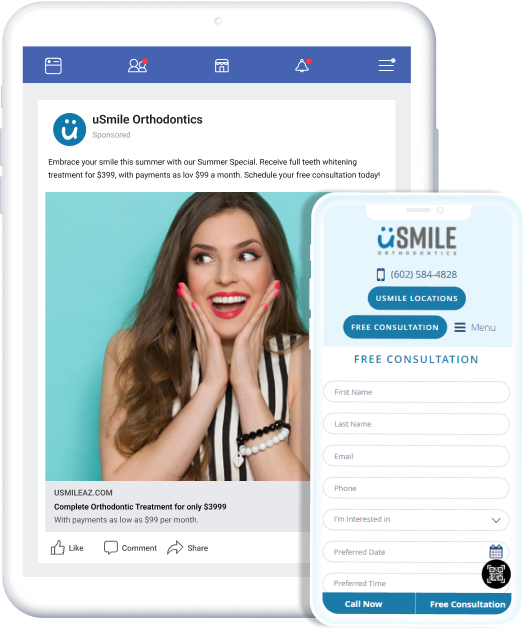
5. A/B Testing for Optimal Results
To optimize the performance of your Facebook ad campaigns, it’s important to conduct A/B testing. Test different variations of your ad creative, including visuals, ad copy, and calls-to-action, to determine which combinations yield the best results. Monitor key metrics such as click-through rates, conversion rates, and cost per acquisition to identify the winning variations and refine your future campaigns accordingly.
Customizing Audience Targeting
1. Geographic Targeting
Geographic targeting allows you to reach potential patients located in specific regions or cities. Depending on the scope of your orthodontic practice, you can narrow down your target audience to the areas where you provide services. By focusing your efforts on reaching individuals in your local area, you can maximize the relevance of your ads and increase the likelihood of attracting patients who have easy access to your practice.
2. Age and Gender Segmentation
Age and gender segmentation is particularly useful when targeting specific demographics that are more likely to require orthodontic treatments. Consider the typical age range of your patients and the gender distribution within your target audience. By refining your targeting based on these factors, you can tailor your messaging and visuals to resonate with a specific age group or gender, increasing the effectiveness of your Facebook ads.
3. Interest-Based Targeting
Interest-based targeting allows you to reach individuals who have expressed interest in topics or activities related to orthodontic treatments. Consider targeting individuals who follow pages or groups related to oral health, cosmetic dentistry, or specific orthodontic procedures. By reaching individuals who have already shown an interest in similar topics, you can be more confident that your ads will be well-received and relevant to your target audience.
4. Behavior-Based Targeting
Behavior-based targeting takes into account user behavior on and off Facebook. Consider targeting individuals who have shown intent to seek orthodontic treatments, such as those who have visited dental websites or engaged with orthodontic content. By focusing on users who have already demonstrated an interest in orthodontics, you can increase the probability of conversion and maximize the return on your ad spend.
5. Lookalike Audiences
Lookalike audiences allow you to reach individuals who share similar characteristics and behaviors to your existing patients or customer base. By leveraging Facebook’s algorithms, you can create custom lookalike audiences that closely resemble your ideal patient profile. This targeting strategy helps expand your reach to new potential patients who are likely to be interested in your orthodontic services based on the behaviors and interests of your existing patients.
Choosing the Right Ad Format and Placement
1. Image Ads
Image ads are the most common and versatile format for Facebook advertising. They allow you to showcase visually appealing images related to your orthodontic brand or treatments. Use high-quality images that capture attention and effectively convey your message. Experiment with different image compositions, colors, and styles to determine which ones resonate most with your target audience.
2. Video Ads
Video ads are highly engaging and can deliver your message in a dynamic and compelling manner. Use videos to showcase patient testimonials, demonstrate how your treatments work, or provide educational content. Keep your videos concise and visually appealing to maintain viewer interest. Consider adding subtitles or text overlays to make your message clear even without sound, as many users watch videos on Facebook with the sound off.
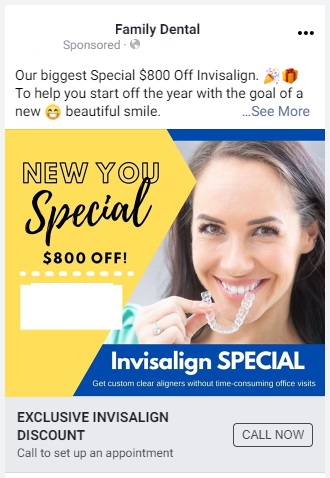
3. Carousel Ads
Carousel ads allow you to display multiple images or videos within a single ad unit. This format is ideal for showcasing different orthodontic treatments or highlighting various aspects of your practice. Each carousel card can contain its own headline, image or video, and call-to-action, making it easy to provide a diverse range of information and engage users with different interests.
4. Collection Ads
Collection ads are designed to encourage product discovery and drive users to make a purchase or take a specific action. This format allows you to present a collection of products or services in a visually appealing layout. Use collection ads to showcase different treatment options or highlight specific offers, guiding potential patients towards the next steps in their treatment journey.
5. Messenger Ads
Messenger ads provide a direct and personalized way to interact with potential patients. By utilizing the Messenger platform, you can deliver targeted ads to users and enable them to initiate conversations with your brand. Messenger ads can be used to answer questions, provide additional information, or schedule appointments, creating a seamless and convenient experience for potential patients.
Setting Up Effective Ad Campaigns
1. Defining Campaign Objectives
Before launching your Facebook ad campaigns, it’s important to clearly define your objectives. Whether it’s increasing brand awareness, generating leads, or promoting specific services, having a well-defined objective will shape your ad strategy and help measure the success of your campaigns. Align your objectives with the needs and preferences of your target audience to ensure that your campaigns resonate with the right individuals.
2. Determining Budget and Bidding Strategy
Setting a budget and determining the appropriate bidding strategy for your Facebook ad campaigns is crucial to maximize your return on investment. Consider your overall marketing budget and allocate a portion to Facebook ads. Experiment with different bidding strategies, such as cost per click (CPC) or cost per thousand impressions (CPM), to find the approach that works best for your goals and budget constraints.
3. Advanced Targeting and Audience Selection
With Facebook’s advanced targeting options, it’s important to take advantage of the available features to narrow down your audience and reach the most relevant individuals. Utilize demographic, interest-based, and behavior-based targeting to refine your audience selection. Test different targeting combinations to determine which ones yield the highest engagement and conversion rates.
4. Ad Scheduling and Frequency
Ad scheduling allows you to control when your ads are shown to your target audience. Consider the peak times when your target audience is likely to be active on Facebook and schedule your ads accordingly. Additionally, carefully manage the frequency at which your ads are shown to avoid overwhelming users with repetitive content. Finding the right balance between exposure and maintaining user interest is vital for campaign success.
5. Ad Creative and Copy Optimization
Continuously optimize your ad creative and copy to improve campaign performance. Monitor key metrics such as click-through rates, conversion rates, and engagement rates to identify ad variations that are performing well and those that need improvement. Test different visuals, ad copy, and calls-to-action to find the winning combinations that resonate the most with your target audience.
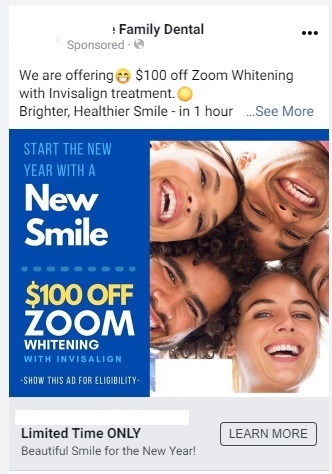
6. Tracking and Analytics
Tracking and analytics play a crucial role in measuring the success of your Facebook ad campaigns. Set up Facebook Pixel on your website to track key conversions and behaviors of users who interact with your ads. Utilize Facebook Ads Manager to monitor campaign performance, track metrics such as reach, impressions, and click-through rates, and identify insights for optimization. Use the data collected to refine your strategies and make data-driven decisions to improve campaign performance.
Implementing Retargeting Strategies
1. Website Custom Audiences
Website custom audiences allow you to retarget individuals who have visited your website but have not taken a desired action, such as scheduling an appointment or making a purchase. By creating a custom audience based on website visitors, you can deliver targeted ads to these individuals and encourage them to return and complete the desired action. Use persuasive ad copy and compelling visuals to entice them back to your website.
2. Dynamic Product Ads
Dynamic product ads are highly effective for retargeting potential patients who have shown interest in specific orthodontic treatments. These ads automatically showcase the exact products or services that users have previously viewed on your website. By delivering personalized ads that align with users’ interests, you can increase the likelihood of conversion and remind individuals of the treatments they were considering.
3. Lead Generation Ads
Lead generation ads are specifically designed to capture user information, such as email addresses or phone numbers. By offering valuable resources, such as free consultations or educational guides, you can entice potential patients to provide their contact details. Once you have collected these leads, you can follow up with targeted ads or email marketing campaigns to nurture the relationship and convert them into patients.
4. Engagement Retargeting
Engagement retargeting allows you to retarget individuals who have engaged with your content on Facebook, such as liking, sharing, or commenting on your posts. By creating custom audiences based on these engagement actions, you can deliver tailored ads that resonate with users who have already shown an interest in your brand. This strategy helps increase brand recall and encourages users to take the next step in their patient journey.
5. Lookalike Audience Expansion
Lookalike audience expansion is a powerful retargeting strategy that allows you to reach new potential patients who share characteristics and behaviors with your existing patients. By creating a lookalike audience based on your customer database, you can expand your reach and target individuals who are likely to be interested in your orthodontic services. This strategy helps increase brand visibility and tap into new markets.
Maximizing ROI with Conversion Tracking and Optimization
1. Setting Up Facebook Pixel
Setting up Facebook Pixel is essential for effective conversion tracking and optimization. Facebook Pixel allows you to track the actions users take on your website after interacting with your Facebook ads. By placing the Pixel code on your website, you can gain valuable insights into user behavior, optimize ad campaigns for specific conversions, and measure the return on your ad spend.
2. Tracking Key Conversions
Identify the key conversions that align with your campaign objectives and track them using Facebook Pixel. Whether it’s appointment bookings, form submissions, or purchases, tracking these conversions allows you to assess the effectiveness of your Facebook ads in driving the desired actions. Use the data collected to make informed decisions and optimize your campaigns for better results.
3. Optimizing Ad Performance
Regularly monitor and optimize your ad performance to maximize your return on investment. Use Facebook Ads Manager to analyze key metrics such as click-through rates, conversion rates, and cost per acquisition. Identify underperforming ads and ad variations, and make necessary adjustments to improve their effectiveness. Experiment with different ad formats, targeting options, and ad placements to find the winning combinations that yield the highest performance.
4. Split Testing and Experimentation
Split testing, also known as A/B testing, is a valuable strategy for optimizing your Facebook ad campaigns. Test different ad variations simultaneously, such as visuals, ad copy, or targeting options, to identify the winning elements that drive the highest engagement and conversion rates. By constantly experimenting, you can refine your strategies, improve campaign performance, and achieve better results.
5. Retention and Repeat Business
While attracting new patients is important, retaining existing patients is equally crucial for long-term success. Facebook ads can be utilized to nurture relationships with existing patients and encourage repeat business. Create targeted ads that offer exclusive discounts, loyalty programs, or referral incentives to keep your patients engaged and incentivize them to continue choosing your orthodontic services.
Measuring Success and Analyzing Results
1. Key Performance Indicators (KPIs)
To measure the success of your Facebook ad campaigns, it’s important to define key performance indicators (KPIs) that align with your campaign objectives. Common KPIs for orthodontic brands include reach, impressions, click-through rates, conversion rates, and cost per acquisition. Regularly monitor these metrics to track campaign performance and make data-driven decisions for optimization.
2. Facebook Ads Manager Metrics
Facebook Ads Manager provides a wealth of metrics and insights to help you analyze the performance of your ad campaigns. Utilize metrics such as frequency, engagement rate, relevance score, and click-through rates to assess the effectiveness of your campaigns. Dive deeper into the data to identify trends, audience preferences, and areas for improvement. Leverage these insights to optimize your campaigns and achieve better results.
3. Conversion Tracking and Attribution
Conversion tracking and attribution are crucial for understanding the impact of your Facebook ads on user behavior. By properly setting up Facebook Pixel and utilizing conversion tracking, you can attribute specific actions to your ad campaigns and measure their impact. Determine which ads or ad variations contribute most to conversions and allocate your ad spend accordingly.
4. Analyzing Cost per Acquisition (CPA)
Analyzing the cost per acquisition (CPA) helps you understand the effectiveness and efficiency of your Facebook ad campaigns. Calculate your CPA by dividing the total cost of your ad campaign by the number of conversions achieved. Track the trends and changes in your CPA over time to identify areas where you can optimize your campaigns and reduce the cost of acquiring new patients.
5. Adjusting Strategies for Improvement
Based on the insights gathered from measuring success and analyzing the results, make necessary adjustments to your Facebook ad strategies. Experiment with different ad formats, targeting options, or campaign objectives to find the optimal approach for your brand. Continuously monitor the performance of your campaigns and respond to changing market dynamics or audience preferences to ensure long-term success.
In conclusion, Facebook ads offer numerous benefits for orthodontic brands, including increased visibility and reach, targeted advertising, cost-effective marketing, and direct communication with potential patients. Understanding your target audience and their demographics, interests, and behaviors is crucial for effective ad campaigns. By establishing clear campaign objectives, crafting compelling ad creative, customizing audience targeting, and choosing the right ad format and placement, you can maximize the success of your Facebook ads. Implementing retargeting strategies, optimizing conversions, and measuring success through tracking and analytics will help you fine-tune your campaigns and achieve a higher return on investment. Through strategic planning, continuous optimization, and data-driven decision-making, orthodontic brands can effectively leverage Facebook ads to boost their brand visibility, attract new patients, and foster patient engagement and loyalty.

